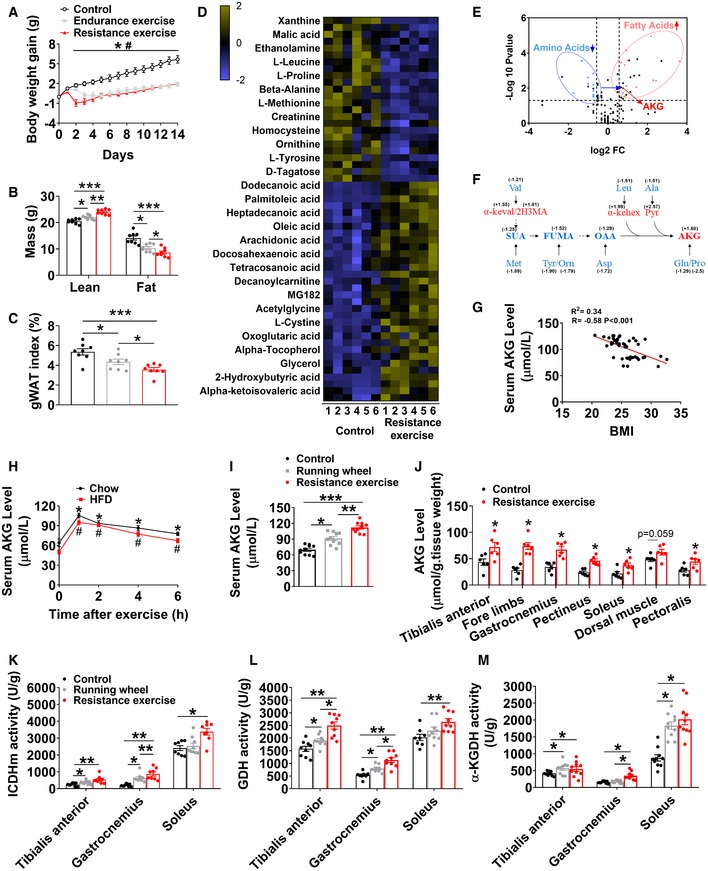-
A–C
Mouse body weight gain (A), lean mass and fat mass (B), and gWAT index (C). At 8 weeks of age, male C57BL/6 mice were switched to HFD. After 12 weeks of HFD feeding, mice were divided into three groups receiving non‐exercise, endurance exercise, or resistance exercise for 14 days (n = 8 per group).
-
D
Relative changes in metabolites in response to resistance exercise. Heat maps show changes in metabolites in the serums from mice receiving resistance exercise or non‐exercise. Male C57BL/6 mice (10 weeks old) fed with normal chow were divided into two groups receiving either non‐exercise or resistance exercise for 40 min (n = 6 per group). Shades of yellow and blue represent fold increase and fold decrease in a metabolite, respectively (see color scale).
-
E
A volcano plot of metabolome. Metabolites with log2FC ≥ 0.58 and −log10
P value ≥ 1.3 were considered significant. Fatty acid (red dots) and amino acid (blue dots) metabolites were found to be significantly different between groups (n = 6 per group).
-
F
Enrichment of tricarboxylic acid cycle (TCA cycle) intermediates/AKG metabolites in serum during resistance exercise. Blue color indicates significant decreases, while red color indicates significant increases by the volcano plot analysis between groups in serum metabolite levels (Val: valine; Leu: leucine; Ala: alanine; Met: methionine; Tyr: tyrosine; Orn: ornithine; Asp: aspartic acid; Glu: glutamic acid; Pro: proline; SUA: succinic acid; FUMA: fumaric acid; OAA: oxaloacetic acid; AKG: oxoglutaric acid; α‐keval: alpha‐ketoisovaleric acid; 2H3MA: 2‐hydroxy‐3‐methylbutyric acid; α‐kehex: α‐ketoleucine; Pyr: pyruvic acid).
-
G
Two‐tailed Pearson's correlation coefficient analysis of plasma AKG level and body mass index (BMI) in Chinese adults (10 males and 35 females).
-
H
Serum AKG concentration–time profile obtained before and after 40‐min resistance exercise. At 8 weeks of age, male C57BL/6 mice were switched to HFD and continuously fed with HFD for 12 weeks. At 20 weeks of age, mice received resistance exercise for 40 min. Another group of chow‐fed male C57BL/6 mice (10 weeks old) received resistance exercise for 40 min. The serum AKG level was tested at 0, 1, 2, 4, and 6 h after exercise (n = 8–10 per group).
-
I
Serum AKG levels after exercise. Male C57BL/6 mice (10 weeks old) fed with normal chow were divided into three groups receiving non‐exercise, free access to running wheel for 1 day, or resistance exercise for 40 min (n = 8–10 per group).
-
J
Muscle AKG levels after exercise. Male C57BL/6 mice (10 weeks old) fed with normal chow were divided into two groups receiving either non‐exercise or resistance exercise for 40 min (n = 6 per group).
-
K–M
Muscle ICDHm (K), GDH (L), and α‐KGDH (M) enzyme activity after exercise. Male C57BL/6 mice (10 weeks old) fed with normal chow were divided into three groups receiving non‐exercise, free access to running wheel for 1 day, or resistance exercise for 40 min (n = 8–9 per group).
Data information: Results are presented as mean ± SEM. In (A), *
≤ 0.05 (Control versus Resistance exercise) by two‐way ANOVA followed by post hoc Bonferroni tests. In (B–C and I–M), *
≤ 0.001 by one‐way ANOVA followed by post hoc Tukey's tests. In (H), *
‐test compared with before exercise.

